It is only a number of years into retirement that the consequences of decisions made early on begin to show. If you are nearing retirement, or you are in early retirement, it is important to be aware of the impact of your decisions. Looking at international research, and applying it in a local context, Michael Summerton gives living annuitants some perspective on the appropriate income levels to draw down (within the 2.5% to 17.5% range as currently prescribed by legislation), and offers some thoughts on asset allocation.
'The question isn't at what age I want to retire, it's at what income' – George Foreman
Only a small proportion of South Africans begin retirement with sufficient capital that will comfortably last the rest of their lives. We all need to make well-informed income and asset allocation decisions early on to give our retirement savings the best chance of going the distance. This will prevent us from being forced into making drastic lifestyle adjustments as we figure out how long we may live, and how quickly our nest eggs may diminish.
Withdrawal rates and asset allocation
Personal circumstances are unique which makes it very difficult to prescribe a 'recommended withdrawal rate'. Various studies have been carried out on the subject to try to give retirees and their financial advisers a solid basis for their decisions. In 1994, US author and financial adviser William P. Bengen conducted extensive research to identify a strategy that would allow his clients the best chance of enjoying real income for at least 30 years (30 years seemed ample for retirement from age 65). Using historical returns going back to the 1920s for equities and bonds in the US, he ran a number of different scenarios using portfolios beginning on 1 January of each year. He built up a dataset of portfolio performance and end market value around the following variables: percentage withdrawal and asset allocation. Bengen came up with a formula for withdrawals and asset allocation and concluded that if you follow his method, you will enjoy inflation-adjusted income for at least 30 years in nearly all circumstances.
INCREASING ANNUAL WITHDRAWALS BY INFLATION ALONE, AND REBALANCING ANNUALLY, IS ESSENTIAL FOR THE 4% RULE TO HOLD
This theory has held through several stock market booms and busts of varying magnitudes.
Bengen suggests:
- Withdraw 4% of your capital, starting at the end of the first year of retirement (for ease of calculation purposes, Bengen used income withdrawals in arrears)
- Increase (or decrease) the absolute cash value of your withdrawal only by inflation each year
- Maintain at least a 50% allocation to equities (if the weightings in your portfolio have changed, but your investment objectives have not, you may need to 'rebalance' annually to restore your original asset allocation)
Bengen's assertion that 4% is an appropriate drawdown rate has since turned into a 'rule of thumb' for many financial advisers planning their clients' post-retirement income. Increasing annual withdrawals by inflation alone, and rebalancing annually, is essential for the 4% rule to hold.
Will this work in the South African context?
Using South African equity and bond data, and similar assumptions to Bengen, we created 84 30-year periods beginning on 1 January 1900.
We concluded that if you had used 55% equity exposure, started your annual withdrawal at 4% and only increased by inflation each year, your income would have lasted for at least 30 years, 93% of the time, as shown in Graph 1.
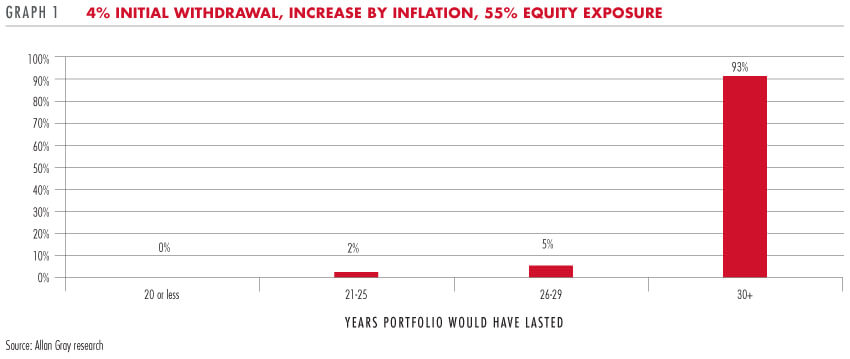
The impact of your drawdown decisions
Graph 2 illustrates what would have happened had you selected an initial drawdown rate of 5%. The change from 4% to 5% may seem like a small increase, but it is in fact a 25% increase in income. While 4% proved sustainable in almost all scenarios, 5% would have run out before 30 years one-third of the time. Note how under the 4% assumption shown in Graph 1, all portfolios lasted more than 20 years, while under the 5% assumption, 7% of portfolios lasted less than 20 years. This illustrates how important the initial level of income is to the long-term sustainability of your portfolio. An initial drawdown rate of 6% would have run out before 30 years nearly two-thirds of the time.
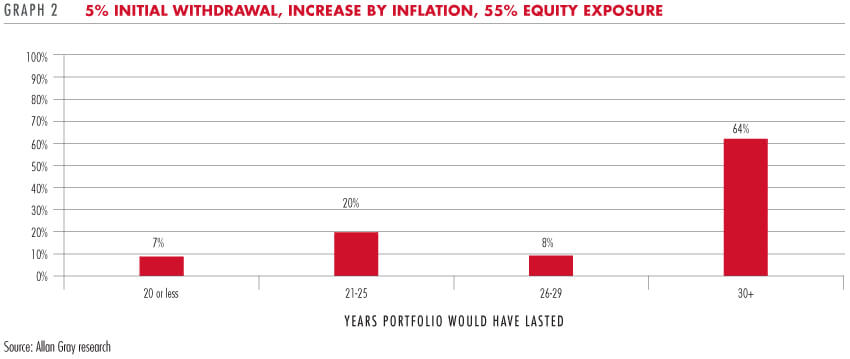
Graph 3 illustrates the impact of selecting 4% at the beginning of retirement and keeping this percentage constant for as long as possible. This shows that it isn't only the initial income level that is important; it is just as important to be disciplined about the increases you allow yourself to take. When bumper returns come along it is advisable to contain your income growth, so that your portfolio can build up a buffer for disappointing returns, which inevitably lie ahead. In this scenario, even though the initial withdrawal percentage was 4%, by then allowing annual withdrawal escalations ahead of inflation, the number of instances the portfolios lasted beyond 30 years reduced to only 54% of the time (which is nearly akin to flipping a coin).
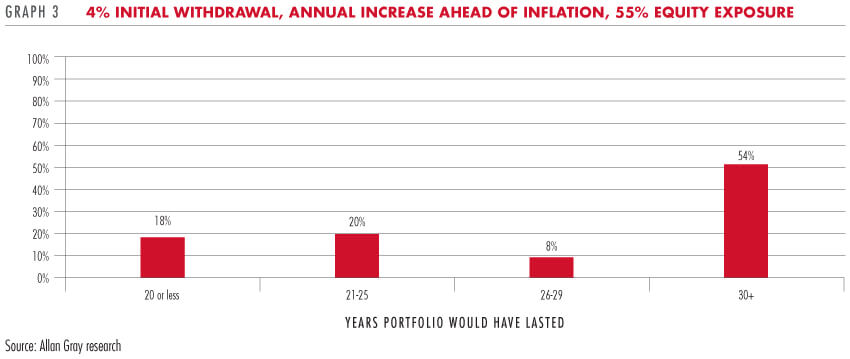
The impact of your asset allocation decisions
Maintaining an appropriate asset allocation throughout retirement is essential. Both Bengen's research and the examples above use total return market data and both assume that annuitants build and rebalance their own portfolios. Another way to achieve appropriate asset allocation is to use a balanced fund, where the professional fund manager is mandated to vary the asset allocation and invest in shares, bonds, money markets and offshore, depending on where they are finding value at the time. Note that the maximum equity exposure limits of these funds vary, so if you are in retirement and keen to follow Bengen's advice and take on at least 50% equity exposure, it is worthwhile looking at the average exposure to equities of your chosen fund over time. Graph 4 and Graph 5 reflect the net equity exposure of the Allan Gray Balanced and Stable funds since inception.
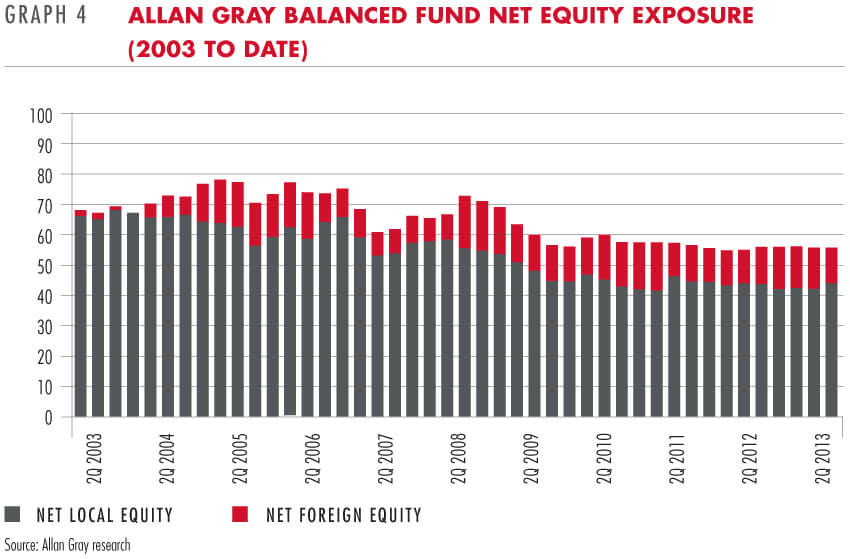
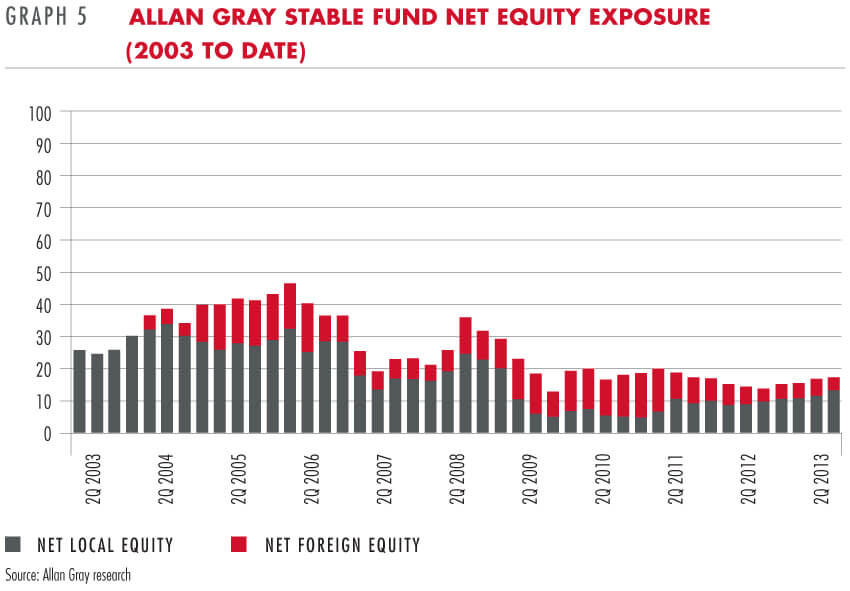
Put the theory into practice
There are various factors that influence the level of income you can draw in retirement, as well as how long your capital will last.
- Level of initial capital
A consistent level of savings over a long enough time horizon, further enhanced by a sensible asset allocation and resisting the temptation to make early withdrawals, provides the best chance of arriving at retirement with a decent capital sum. By the time you reach retirement, there is unfortunately very little that can be done about the value of capital that you have; but you can be smart about making it work for you.
- Inflation
Inflation eats away at your spending power. It is the antithesis to the wonder of compound interest. Even over the medium term, if your investment does not keep up with inflation, it will quickly erode your retirement capital. In addition to the'headline' inflation rate published by the government, you should also consider your personal inflation rate, as some specific costs that retirees face (like medical care) may increase at a higher rate.
- Withdrawal rate
Your withdrawal rate will affect how long your capital lasts. The more income you draw each year, the quicker your capital will erode. Instead of drawing the same percentage in your living annuity each year, you should rather calculate what a reasonable increase would be in absolute rand terms, taking inflation into account and amending your percentage accordingly. Some successful living annuitants have reduced their percentage drawdown over time, which extends the time their capital will last.
- Investment returns
Depending on your appetite for risk and thus your investment's level of exposure to equities, your returns may vary. Over the long term, a higher equity weighting generally leads to higher returns, but with increased volatility and an increased probability of a worse outcome. A lower equity weighting generally leads to lower returns on average, with lower volatility, but a lower chance of a very bad outcome.
If you can manage by initially drawing 4% of your retirement capital without suffering major lifestyle adjustment, increase the rand value of your withdrawals only by inflation, and maintain a suitable asset allocation over time, your money has an excellent chance of outliving you.
Retirement is the beginning of the next stage of your investing life. Careful planning and understanding the impact of your early decisions can increase the longevity of your investment. It is possible to grow your capital at an appropriate rate, while also providing a real, sustainable income. If you are uncertain of the best course of action, you may wish to consider speaking to an independent financial adviser.